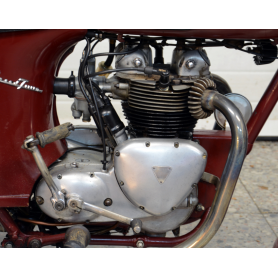No products
Prices are tax excluded
Detailed privacy of the user registry: Here
Legal notice and detailed cookies policy. By continuing to use the site, you accept our use of cookies: Find out more.
241.7
Refurbished
1st registration: 1961. Insurance and MOT in force.
Triumph Motorcycle. Original model Speep-twin.
Tuition Historical. Such as it is. Engine: 2/4590cc.
Budget custom restoration for exhibition in our workshops.
In perfect state of functioning.
Warning: Last items in stock!
Availability date:

Triumph Speeptwin 500cc 1961
1st registration: 1961. Insurance and MOT in force.
Triumph Motorcycle. Original model Speep-twin.
Tuition Historical. Such as it is. Engine: 2/4590cc.
Budget custom restoration for exhibition in our workshops.
In perfect state of functioning.
Recipient :
* Required fields
or Cancel
Triumph Speeptwin 500cc 1961
Manufacturer | Triumph |
Production | 1938-1940 1947-1966 |
Engine | 498 cc, 360-degree dual parallel OHV four-stroke |
Power | 27 HP @ 6300 rpm |
Transmission | 4 speed / chain |
Distance between axes | 55 inch (140 cm) |
The speed Twin 5T is a motorcycle that was made by triumph at their Coventry, and later the factories of Meriden. Edward Turner, chief designer of the Triumph, and the Director-General, launched the Triumph Speed Twin at the 1937 National Motorcycle Show. It was a double vertical of 500 cc OHV in a light structure, and the first twin parallel british really successful, setting the standard for many twins to follow. After the Second World War, the Twin rate was responsible for the survival of Triumph -. And every british brand important offered a twin, 500 cc, designed on similar lines to the twin speed [1]
The side calendar of 1937 motor Speed Double
Triumph twin, Edward Turner was a significant turning point for the british motorcycle industry, as although a 500 cc two-cylinder parallel of medium capacity was not revolutionary, the model 5T speed twin was lighter than a lot of singles in a contemporary style with a lot more power and torque. The first models were only available in 'Amaranth red' with pinstripes of gold hand-painted to pop off the chrome. Initially the one piece iron cylinder was secured with six studs which led to weakness, so these were replaced by eight studs. The two cylinders were fed by a single Amal Type 6 carburettor and many features such as the transmission and clutch were straight . The only win Originally with bent beam, the saddle coil was the only rear suspension as the speed Twin had a rigid frame -. Also from the production line of a single cylinder On the night of 14 November 1940, the largest in the centre of the city of Coventry was destroyed by German bombs, and the factory of Triumph (which was working on an order of thousands of 5T military specification) was completely annihilated, and all technical records, drawings and designs of Triumph were destroyed.
Development
The drive side of the engine 1958 Double Speed
After the war the recovery of Triumph at Meriden was largely due to the double speed, which was developed in 1946 with telescopic forks and optional hub springs rear suspension. The area of the headlights and the instrument is set up in 1949 with the Turner-designed nacelle, a feature maintained until the end of the line models. In 1953, the Twin speed caused controversy among the british riders traditional as the generator and magneto were replaced with a Lucas alternator and ignition system battery / coil.
The 1959 Twin-note 5TH speed rear fairing 'bath' and headlight nacelle.
A further development led to the model 5TH 1959 with a motor drive and the construction gearbox and styling changes including the fairing unpopular 'bathtub', which became more and more abbreviated as the model developed before disappearing altogether for the final year of production in 1966.
The drive motor 500 continued development in the parallel Tiger 100 range and finishing with Tiger Daytona models that ceased production in 1973.
No customer reviews for the moment.
Seriousness guarantee